
Helping Those Most in Need
Bank of America Makes $750,000 Gift to
Neonatology
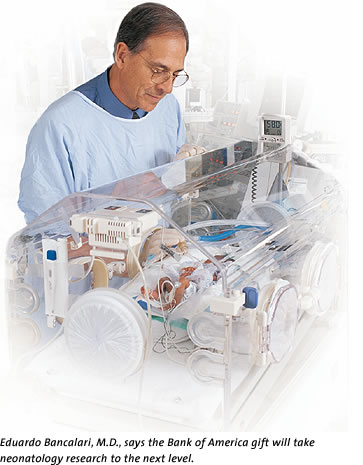
![]() hanks
to the continuing generosity of Bank of America, the Miller School
of Medicine and Holtz Children’s Hospital will be able to
enhance the research capabilities and facilities of the Neonatal
Special Care Center.
hanks
to the continuing generosity of Bank of America, the Miller School
of Medicine and Holtz Children’s Hospital will be able to
enhance the research capabilities and facilities of the Neonatal
Special Care Center.
Continuing its philanthropic support and commitment to South Florida, Bank of America President Rob Hilson announced the $750,000 campaign gift. “Our support for the Department of Pediatrics reinforces our longstanding commitment to and relationship with the University of Miami,” Hilson said. “We are delighted to partner with the Miller School of Medicine and Jackson Memorial’s Holtz Children’s Hospital to increase positive outcomes in the care of the smallest and sickest infants.”

Since its inception, the Division of Neonatology has cared for premature and critically ill babies from South Florida, the Caribbean, and Central and South America in its intensive care unit.
The reasons premature infants are so vulnerable to lung injury and chronic lung disease are not known, but suspected possibilities include lung immaturity and damage from oxygen and mechanical ventilation as well as lung inflammation and infection.
“Thanks to Bank of America, we will be able to take this cutting-edge research to the next level by developing a Molecular and Cell Biology Neonatal Research Laboratory that will explore normal and abnormal lung development,” said Eduardo Bancalari, M.D., professor of pediatrics and chief of the Division of Neonatology. “The creation of this centerwill enable us to develop new insights into how the newborn lung develops and how we might prevent and treat devastating lung diseases such as neonatal chronic lung disease.”
In addition to supporting the creation of the Molecular and Cell Biology Neonatal Research Laboratory, Bank of America is helping to underwrite needed renovations to the neonatal intensive care unit. Currently the NICU houses 126 beds, 66 of which are neonatal intensive care unit stations. The renovation will help provide improved facilities for physicians, nurses, and respiratory therapists as well as maximize support with radiology and pharmacy services.
In presenting the gift, Maria C. Alonso, Bank of America senior vice president for market development, noted that the commitment is part of the bank’s Neighborhood Excellence program. “Neighborhood Excellence is about identifying critical issues in local communities and directing resources to address those priorities,” Alonso said. “By supporting this program, Bank of America can contribute to the growth of the University of Miami/Jackson Memorial Medical Center as a major engine of economic activity and growth in Miami-Dade County.”
$1 Billion and Counting
Momentum Campaign Surpasses Goal
![]() little
more than two years after publicly kicking off an ambitious $1 billion
initiative, Momentum: The Campaign for the University of Miami surpassed
its goal ahead of schedule at the end of January. As of April 30, the
total had reached $1,097,661,337, which comes from a record 108,947 donors,
of whom 182 have given $1 million or more.
little
more than two years after publicly kicking off an ambitious $1 billion
initiative, Momentum: The Campaign for the University of Miami surpassed
its goal ahead of schedule at the end of January. As of April 30, the
total had reached $1,097,661,337, which comes from a record 108,947 donors,
of whom 182 have given $1 million or more.
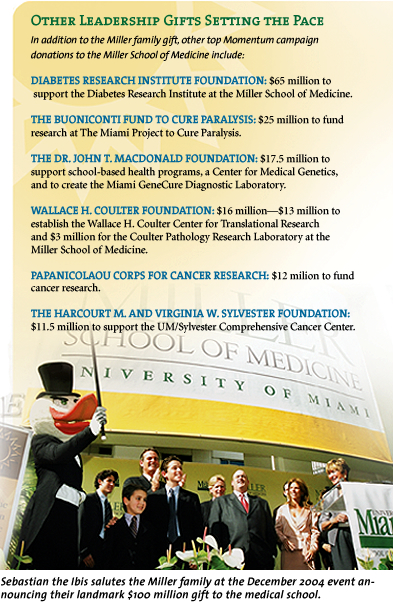 The Miller School of Medicine is well on the way to
reaching its campaign goal of $700 million. By accomplishing its initial
goal 18 months ahead
of schedule, the University joins a group of elite universities that
have reached the $1 billion club.
The Miller School of Medicine is well on the way to
reaching its campaign goal of $700 million. By accomplishing its initial
goal 18 months ahead
of schedule, the University joins a group of elite universities that
have reached the $1 billion club.
Dean Colson, J.D. ’77, chairman of the Board of Trustees and campaign chair, says, “Hitting the billion-dollar mark is the best incentive to keep going.” The campaign goal has been increased by $250 million, with a target date of the end of 2007.
The largest gift to the campaign to date is a $100 million gift from the family of the late Leonard M. Miller, a longtime South Florida businessman, UM Board of Trustees chairman, and philanthropist. In recognition of the gift, the School of Medicine was named the Leonard M. Miller School of Medicine in December 2004.
“The campaign has generated unpre-cedented levels of giving from University alumni, trustees, friends, and grateful patients,” says Marsha P. Kegley, associate vice president for medical development and alumni relations. “The generosity of donors will accelerate cutting-edge research and with it the promise of unlocking the mysteries to many devastating illnesses.”
Bernard J. Fogel, M.D., dean emeritus and co-chair of the medical school campaign, says: “The campaign started under the leadership of Jay Weiss. In turn, Jay hand-picked Norman Braman to step into his shoes. The medical school could not have been more fortunate because of the passion both men have toward the school. We have made tremendous progress, but there is still a ways to go. I am confident that we will be successful in obtaining the resources needed to carry out our extraordinary mission.”
Walk it Like You Talk
It
Giving Back to the Community—and the Miller
School
![]() t’s
early spring 1979. George Bergmann, a successful South Florida businessman
and philanthropist, is engaged in another building project. He asks his
crane operator to take him to the roof so he can get a bird’s-eye
perspective of the site. Despite the smooth landing, he feels a twinge
of pain in his back.
t’s
early spring 1979. George Bergmann, a successful South Florida businessman
and philanthropist, is engaged in another building project. He asks his
crane operator to take him to the roof so he can get a bird’s-eye
perspective of the site. Despite the smooth landing, he feels a twinge
of pain in his back.
Fast forward a couple months to late June. Bergmann is having breakfast when he suddenly experiences terrible pain in his back. Before sunset that evening he would be unable to walk. He sees countless doctors, each recommending various forms of treatment. One doctor was blunt in describing Bergmann’s prognosis: “You’ll never walk again.”
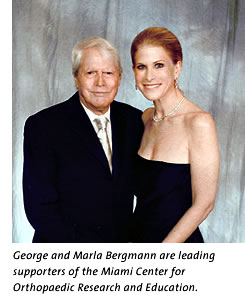 The energetic businessman was now confined to
bed. Then a good friend referred him to an orthopaedic surgeon by the
name of Charles Weiss,
M.D. Weiss, a University of Miami Miller School of Medicine voluntary
faculty member since 1978, examined Bergmann, reviewed his X-rays,
and declared, “You’re going to rehabilitate yourself!” recalls
Bergmann.
The energetic businessman was now confined to
bed. Then a good friend referred him to an orthopaedic surgeon by the
name of Charles Weiss,
M.D. Weiss, a University of Miami Miller School of Medicine voluntary
faculty member since 1978, examined Bergmann, reviewed his X-rays,
and declared, “You’re going to rehabilitate yourself!” recalls
Bergmann.
Following Weiss’s regimen, Bergmann was virtually pain-free until four years ago. While on a family trip, Bergmann’s wife, Marla, tripped and badly injured her foot. On the return trip home, he carried both of their carry-on bags. Soon there-after, Bergmann experienced severe neck pain.
Weiss referred him to Frank Eismont, M.D., chief of UM Spine Surgery and co-chairman of the Department of Orthopaedics and Rehabilitation. Eismont reviewed his X-rays and, in turn, referred him to another colleague for rehabilitation. Once again, Bergmann recovered.
The experiences with Weiss and Eismont convinced Bergmann that he needed to have a different relationship with the Miller School other than that of a patient. He became involved with Miami CORE (the Miami Center for Orthopaedic Research and Education), the fundraising arm of the Department of Orthopaedics and Rehabilitation.
Recently, the Bergmanns made a $250,000 planned gift to the Momentum campaign. “Marla and I feel very strongly that when you live in a community you must give back to the community. It will only bring positive things back to you.”
|
Feldmans Continue Their Support of CRME
Feldman and his neighbors, including former Miller School Associate Dean Bea Dossick, helped found Friends For Life, which raises money for many medical school initiatives. Harry Feldman’s life and generosity are deeply rooted in a simple philosophy: “As part of my outlook on how I should live in this world, I like to take care of people,” he says. |
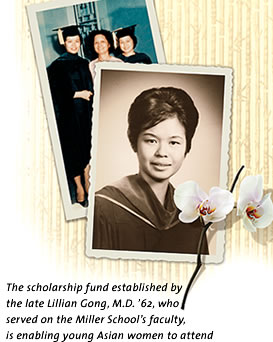 Helping Other Asian Women
Fulfill Their Dream
Helping Other Asian Women
Fulfill Their Dream
Late Miller School Alumna
Establishes Scholarship Fund
![]() he
late Lillian Gong, M.D. ’62, was by all accounts a compassionate
woman who never forgot her humble background. She often vowed that
someday she would help other young Asian women realize their dream
of attending medical school. And she did, by creating the University
of Miami Miller School of Medicine’s Lillian Gong Scholarship
for Asian Women.
he
late Lillian Gong, M.D. ’62, was by all accounts a compassionate
woman who never forgot her humble background. She often vowed that
someday she would help other young Asian women realize their dream
of attending medical school. And she did, by creating the University
of Miami Miller School of Medicine’s Lillian Gong Scholarship
for Asian Women.
The daughter of Chinese immigrants who settled in Miami during the 1920s and ran a small grocery store in the Overtown area, Lillian was a quiet, introspective woman with an innate ability to understand people.
“She could walk in a person’s shoes and immediately understand the need to help them,” recalls Gong’s sister, May Jewel Ciemins, M.D., herself a 1962 graduate of the Miller School of Medicine. “She just had that extra sense about her.”

From early on, the Gong sisters dreamed about becoming doctors. However, with three other siblings and a modest income from the small family grocery, the dream nearly died. “Back in those days there weren’t too many women in medicine,” May says. “You were pigeonholed into a mold, and you could never even think of doing something else.”
Lillian decided to pursue a career as a lab research technician following graduation from Wesleyan College in Macon, Georgia, where she was president of the student body. (All five of the Gong siblings went on to college.) She began her career working in biochemistry research at New York University’s Bellevue Medical Center.
May remembers telling her sister that she had been accepted to the University of Miami medical school. “You are smarter than most of the guys at Bellevue,” she told Lillian. “You should rethink your dream.” Lillian did and entered UM, where both sisters graduated in 1962. Lillian was a member of Alpha Omega Alpha, the national honor medical society.
“Lillian was always very interested in children, particularly adolescents,” May recalls. “She adopted kids from all over. When it came time to select a specialty, Lillian knew pediatrics was her calling.”
She went on to earn a master’s in public health from the University of California, Berkeley. Lillian returned to Miami as the associate director of the Comprehensive Health Care Project at UM, the forerunner of today’s Mailman Center for Child Development.
Lillian was a well-respected clinician and administrator, serving on the Miller School’s board of admissions. “My sister could relate on every level with the students,” May remembers. “That ability was one of her strongest and most enduring characteristics.”
In 1970 Lillian relocated to Los Angeles, where she worked as a pediatrician in an East Los Angeles child and youth clinic. At the time of her death she was chief of the Central District Health Center of Los Angeles County.
“I think my sister was a brilliant woman,” May recalls. “I truly believe she was a role model for a lot of young women who believed in a dream and overcame whatever obstacles to fulfill their wishes.”
Helen Han, a third-year medical student, is a recipient of the Lillian Gong Scholarship for Asian Women.
“Being one of three East Asians in a class of 140, I take great pride in my heritage and feel honored that two strong and ambitious Asian-American physicians have made it possible for more Asian-American women like myself to benefit from their success,” she says.
|
|
|
|
|
|
|
|
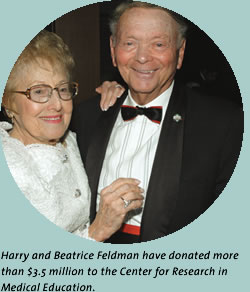 “The generosity of people like Harry and Bea has helped to transform the
Miller School of Medicine into a recognized world leader in emergency skills
training for paramedics, firefighters, hospital workers, and law enforcement
officers as well as medical students,” says Michael S. Gordon, M.D., Ph.D.,
associate dean and director of the CRME. “Harry and Bea have been instrumental
in helping the CRME establish its reputation as one of the preeminent training
centers for first responders in the country.”
“The generosity of people like Harry and Bea has helped to transform the
Miller School of Medicine into a recognized world leader in emergency skills
training for paramedics, firefighters, hospital workers, and law enforcement
officers as well as medical students,” says Michael S. Gordon, M.D., Ph.D.,
associate dean and director of the CRME. “Harry and Bea have been instrumental
in helping the CRME establish its reputation as one of the preeminent training
centers for first responders in the country.”